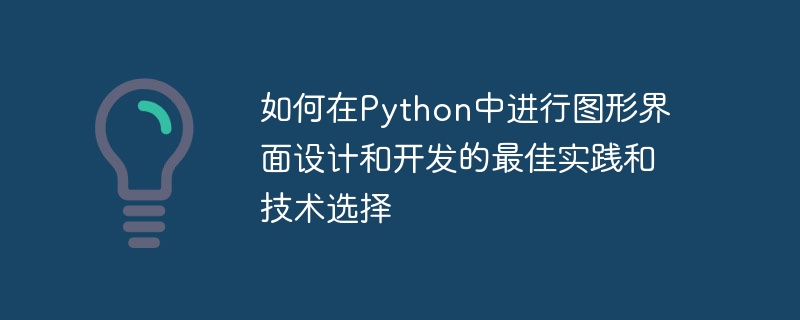
Best practices and technical choices for how to design and develop graphical interfaces in Python
Introduction:
With the rapid development of computer technology, graphical interfaces It has become one of the main ways of human-computer interaction. As a programming language, Python also provides a wealth of tools and libraries for graphical interface design and development. This article will introduce the best practices and technical choices for graphical interface design and development in Python, and give specific code examples.
1. Best Practices
- Focus on user experience: When designing graphical interfaces, always pay attention to user experience to ensure that the interface is intuitive, easy to use, and beautiful. Consider user habits and psychological expectations and provide clear instructions and feedback.
- Modular design: Split the interface into small modules, adopt object-oriented thinking for design, and use encapsulation and inheritance to improve the reusability and maintainability of the code.
- Use appropriate layout managers: Python provides a variety of layout managers, such as Grid, Pack and Place. Choose the appropriate layout manager according to actual needs to make the interface layout more flexible and adapt to different screen sizes. .
- Use appropriate controls: Python's graphical interface library provides a wealth of controls, such as buttons, labels, text boxes, drop-down boxes, etc. Choose appropriate controls according to needs to make user operations more convenient.
- Asynchronous processing: When developing graphical interfaces, avoid time-consuming operations in the main thread. You can use multi-threading or asynchronous programming to improve the responsiveness and fluency of the interface.
2. Technology Selection
- Tkinter: Tkinter is a graphical interface library in the Python standard library. It has complete functions and is easy to learn and use. It can be combined with various layout managers for interface design and supports a variety of controls and event processing. The following is a simple example code for using Tkinter to create a window:
import tkinter as tk
# 创建窗口
window = tk.Tk()
window.title("Hello Tkinter")
window.geometry("400x300")
# 创建标签
label = tk.Label(window, text="Hello, World!", font=("Arial", 20))
label.pack()
# 进入消息循环
window.mainloop()Copy after login
- PyQT: PyQT is a powerful graphical interface development library with rich controls and powerful customization capabilities. It is developed based on Qt and provides a Python interface. The following is a simple example code for creating a window using PyQT:
import sys
from PyQt5.QtWidgets import QApplication, QWidget, QLabel
# 创建应用程序对象
app = QApplication(sys.argv)
# 创建窗口
window = QWidget()
window.setWindowTitle('Hello PyQT')
window.setGeometry(100, 100, 400, 300)
# 创建标签
label = QLabel('Hello, World!', parent=window)
label.move(150, 150)
# 显示窗口
window.show()
# 运行事件循环
sys.exit(app.exec_())Copy after login
- wxPython: wxPython is an open source graphical interface development library based on Python, encapsulating the C library wxWidgets. It provides rich controls and flexible layout managers, supporting cross-platform use. The following is a simple example code for creating a window using wxPython:
import wx
# 创建应用程序对象
app = wx.App()
# 创建窗口
frame = wx.Frame(None, title='Hello wxPython', size=(400, 300))
# 创建标签
label = wx.StaticText(frame, label='Hello, World!', pos=(150, 150))
# 显示窗口
frame.Show()
# 运行事件循环
app.MainLoop()
Copy after login
Summary:
This article introduces the best practices and technical choices for graphical interface design and development in Python, and gives Concrete code examples for creating windows using Tkinter, PyQT and wxPython. According to actual needs and personal preferences, choosing the appropriate graphical interface library and development tools can quickly and efficiently design and develop graphical interfaces.
The above is the detailed content of Best practices and technical choices for how to design and develop graphical interfaces in Python. For more information, please follow other related articles on the PHP Chinese website!

